Discover the Mystery of the Trinity
Unlocking God’s Love and Unity
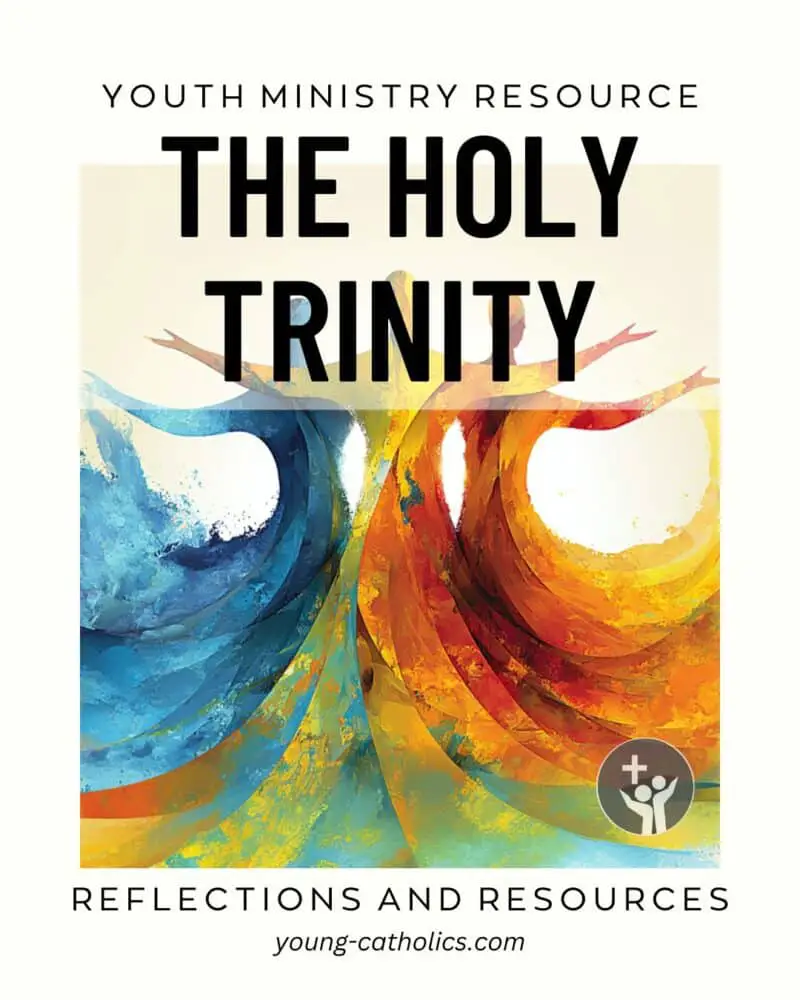
The Trinity means that God is one being in three persons: the Father, the Son, and the Holy Spirit. Each person is fully God. This is a key belief in the Catholic faith. It shows us that God is love and relationship.
This belief is very important to Catholics. It tells us about the nature of God. It helps us understand how God interacts with us. It also shows us how we should live in love and community with others.
The Trinity is a mystery. This means we cannot fully understand it with our minds. We know about the Trinity because God has revealed it to us. We trust in this mystery through our faith.
Understanding this mystery can be hard. It goes beyond what we can see and touch. But God wants us to know Him, so He helps us through the Church and the Bible. By learning about the Trinity, we get closer to God.
We say that God is three persons but one being. This means that while the Father, Son, and Holy Spirit are distinct, they are united. They are perfectly one in their love and purpose. This is a deep truth about God.
Knowing about the Trinity helps us understand how to pray and relate to God. We can talk to the Father, Jesus, and the Holy Spirit in different ways. Each person of the Trinity shows us a different aspect of God’s love. This helps us feel closer to God in our daily lives.
Understanding the Mystery of the Trinity
God has revealed the Trinity to us. We know about the Father, Son, and Holy Spirit because God has shown us. The Bible tells us about this mystery. The Church also teaches us about the Trinity.
The Trinity means that God is one substance but three persons. This can be hard to understand. It means that the Father, the Son, and the Holy Spirit are all fully God. They are not parts of God but each one is God.
God is love. This love is shown in the relationship between the Father, the Son, and the Holy Spirit. They love each other perfectly. This perfect love is the heart of the Trinity. It shows us that God is all about love and relationship.
The Father, the Son, and the Holy Spirit are different but united. The Father is the creator. The Son, Jesus, came to save us. The Holy Spirit helps and guides us. Each person of the Trinity has a special role but they are always one.
When we pray, we can talk to each person of the Trinity. We can thank the Father for creating us. We can ask Jesus for help and forgiveness. We can ask the Holy Spirit for strength and guidance. This helps us connect with God in many ways.
Understanding the Trinity helps us understand God better. It shows us that God is not distant but close to us. It teaches us that love and relationships are important. By learning about the Trinity, we can grow in our faith and love for God.
The Three Persons of the Trinity
The Trinity is made up of three persons: the Father, the Son, and the Holy Spirit. Each person is fully God. The Father is not the Son or the Holy Spirit. The Son is not the Father or the Holy Spirit. The Holy Spirit is not the Father or the Son. But all three are one God.
Even though the Father, Son, and Holy Spirit are different, they are united. They share the same essence. This means they are one in being. They are not three separate gods but one God in three persons. This unity is a mystery we believe through faith.
The Catechism of the Catholic Church explains this well.
The divine persons do not share the one divinity among themselves but each of them is God whole and entire: “The Father is that which the Son is, the Son that which the Father is, the Father and the Son that which the Holy Spirit is, i.e. by nature one God.”
Catechism of the Catholic Church 253
This means all three are fully God, sharing the same nature.
The Father is the creator of all things. He is the source of everything. The Son, Jesus Christ, became man to save us. He shows us God’s love and mercy. The Holy Spirit is our helper and guide. He gives us strength and wisdom.
Even though the Father, Son, and Holy Spirit have different roles, they work together perfectly. Their unity shows us the perfect love and harmony in God. This helps us understand that God is not distant or divided but one and close to us.
Knowing about the three persons of the Trinity helps us relate to God better. We can see how each person of the Trinity plays a part in our lives. This understanding deepens our faith and helps us grow closer to God.
Images and Analogies of the Trinity
Lover, Beloved, and Love
One way to understand the Trinity is by thinking of it as Lover, Beloved, and Love. The Father is the Lover, the one who loves. The Son, Jesus, is the Beloved, the one who is loved. The Holy Spirit is the Love that flows between the Father and the Son. This shows us that God is a relationship of perfect love.
We can relate to each person of the Trinity in different ways. We can give thanks to the Father for creating us and the world. We can pray to Jesus for help and forgiveness. We can ask the Holy Spirit for guidance and inspiration. This helps us connect with God in our daily lives.
Formlessness, Form, Energy
Another image of the Trinity is Formlessness, Form, and Energy. The Father is Formlessness, the source of all things. The Son, Jesus, is Form, who became human and showed us God’s love. The Holy Spirit is the Energy, the living force that moves and inspires us. This shows us that God is the force behind all creation.
This image helps us understand that God is active in the world. The Father creates, the Son saves, and the Holy Spirit empowers. Each person of the Trinity has a role, but they all work together. This unity shows us that God is always at work in our lives and in the world.
Love Triangle
The Trinity is often shown as a triangle. The Father, Son, and Holy Spirit are at each point of the triangle. This shows their unity and equality. Sometimes, the triangle is made of intertwined arcs, showing their connection. Traditionally, the Father is at the top of the triangle, with the Son and the Holy Spirit at the bottom.
We can also think about switching the positions of the Son or the Holy Spirit to help us understand that no person of the Trinity rules over the others. This helps us see the Trinity as a relationship of equals, where each person loves and supports the others. This can make it easier to grasp the mystery of the Trinity.
Water Wheel of Flowing Love
St. Bonaventure compared the Trinity to a water wheel with three buckets. The same water flows through all three buckets. This shows the unity of the three persons in the Trinity. The flowing water represents love, which is what God is. This image highlights the dynamic and flowing nature of God’s love.
The water wheel shows that each person of the Trinity is always in motion, always giving and receiving love. This helps us understand that God’s love is not static but always active. It is a continuous flow that never stops. This image can inspire us to see God’s love as ever-present and ever-moving in our lives.
Movement of Love
The Trinity can also be seen as a movement of love. Instead of a static image like a triangle, think of the Trinity as a circle of movement. The Father, Son, and Holy Spirit hold hands in a spinning dance, each moving and reaching toward the others. This joyful swirl of love shows the active and relational nature of God.
Seeing the Trinity as a movement helps us understand that God is not distant or unchanging. God is always moving, always loving, and always reaching out to us. This image can help us feel closer to God and see Him as a joyful and loving presence in our lives.
Learn about how the Trinity is a dance
The Shamrock
St. Patrick used the shamrock to explain the Trinity. The shamrock has three leaves but is one plant. Each leaf represents a person: the Father, the Son, and the Holy Spirit. This simple image helps us see that the Trinity is three in one.
The shamrock is an easy way to understand the unity and diversity of the Trinity. Just as the shamrock is one plant with three leaves, God is one being with three persons. This image has been helpful for many people in understanding the basic concept of the Trinity.
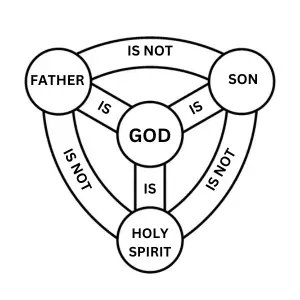
The Shield of the Trinity (Scutum Fidei)
The Shield of the Trinity is a visual representation that shows the relationship between the Father, the Son, and the Holy Spirit. It is a diagram with a central circle labeled “God” and three outer circles labeled “Father,” “Son,” and “Holy Spirit.” Lines connect each outer circle to the central circle and to each other, with labels showing their relationships.
This image helps us see that the Father, Son, and Holy Spirit are all God but are not each other. It clearly shows the unity and distinction within the Trinity. This visual aid has been used for centuries to teach about the Trinity.
See a larger image of the Shield of the Trinity (Scutum Fidei)
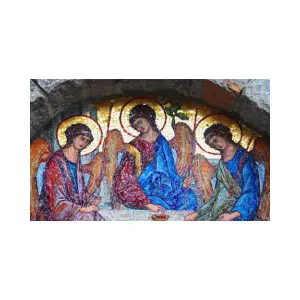
Icon of the Trinity by Andrei Rublev
The icon of the Trinity by Andrei Rublev is a famous painting that depicts the three persons of the Trinity as divine beings sitting around a table. This image emphasizes the unity and equality of the Trinity. The beings are shown in a circle, symbolizing their eternal and loving relationship.
This icon helps us meditate on this mystery. It shows the peaceful and harmonious relationship between the Father, the Son, and the Holy Spirit. This artistic interpretation can draw us into a deeper understanding of God’s nature.
Get a copy of this icon of the Trinity
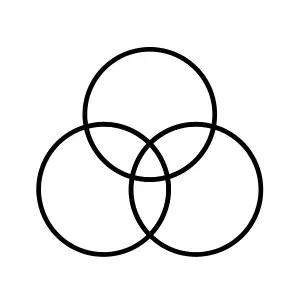
Three Intertwined Circles
Three intertwined circles is another symbol of the Trinity. The circles overlap, showing the unity of the Father, the Son, and the Holy Spirit. Each circle is distinct, yet they are all connected. This image represents the continuous and eternal relationship of the three persons.
This symbol helps us see that while the Father, the Son, and the Holy Spirit are different, they are always one. The overlapping circles remind us of their unity and connection. This simple yet powerful image can help us grasp the mystery of the Trinity.
More Resources

What Is the Trinity? LifeTeen Explains: This video from Life Teen also has a nice explanation of what it means to be “eternally begotten” and “consubstantial”. This is helpful for a study of the Creed.
Social Media Graphics and Bulletin Artwork
Eternal Communion
Celebrate the mystery of the Holy Trinity with this vivid and inspiring image. Perfect for bulletins, newsletters, or catechetical resources, it beautifully reflects the unity and harmony of Father, Son, and Holy Spirit.
Download this artwork to bring color and meaning to your parish or classroom materials, encouraging reflection on the love and oneness of God.
Paid subscribers may download a large copy this digital artwork without watermarks, suitable for use in bulletins, social media, newsletters, etc., free of charge by clicking here. You must be logged in as a paid subscriber to access the file.
Only current paid subscribers have the rights to use the artwork.
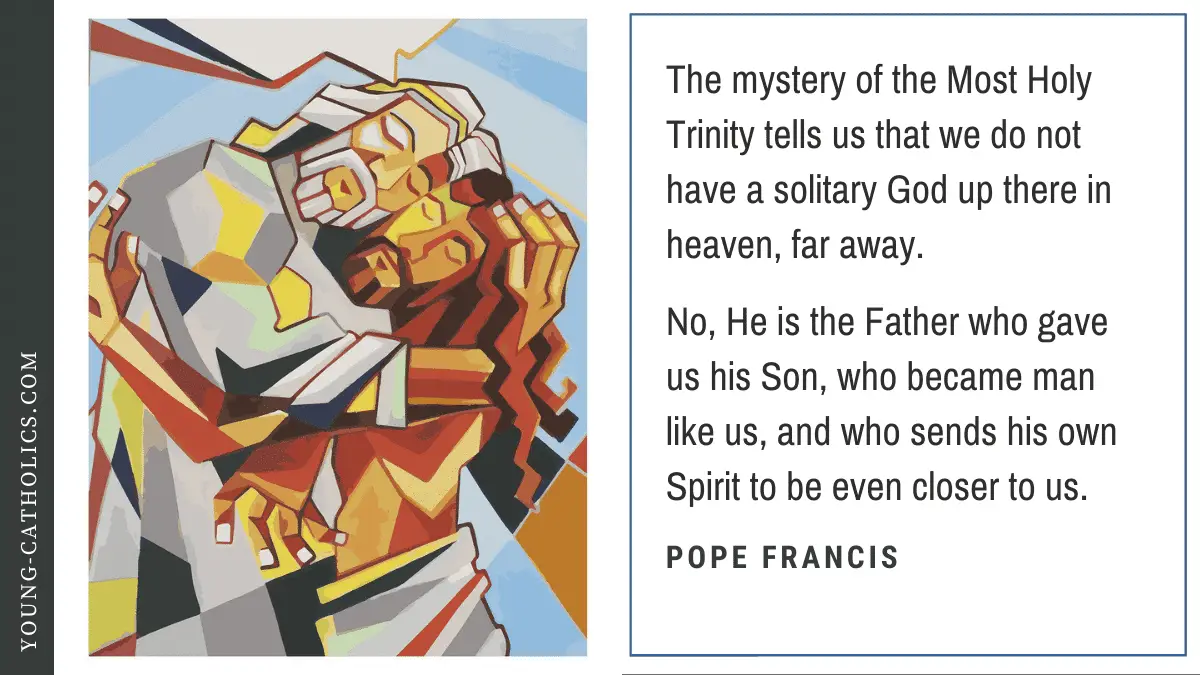
Questions and Answers
Why is the Trinity a mystery?
It is a mystery because it is beyond our full understanding. We can only know about the Trinity because God has shown it to us. Our minds cannot completely grasp how one God can be three persons. We accept this truth through faith.
How can God be three persons in one?
God is three persons in one being. The Father, the Son, and the Holy Spirit are each fully God. They are not three separate gods. They are united as one. This means they share the same essence but are distinct in their persons.
What does it mean that God is love?
God is love because the Father, the Son, and the Holy Spirit love each other perfectly. This love is the very nature of God. It shows us that God is all about relationships. God’s love is also shown to us through Jesus and the Holy Spirit.
How do we experience the Trinity in daily life?
We experience this mystery in many ways. We can pray to the Father, thanking Him for creation. We can ask Jesus for help and forgiveness. We can ask the Holy Spirit for guidance and strength. God is always with us, helping us in our lives.
Why is the Trinity important to our faith?
It is important because it tells us who God is. It shows us that God is a relationship of love. Understanding this mystery helps us know God better. It also helps us see how we should live in love and unity with others.
How can I explain the Trinity to others?
You can use simple images and analogies. For example, you can use the shamrock, three-leaf clover, to show how one plant has three leaves. You can also use the idea of Lover, Beloved, and Love to explain the relationship of the three persons. These images help make the concept easier to understand.
Three in One
The Trinity is a central belief in the Catholic faith. It teaches us that God is one being in three persons: the Father, the Son, and the Holy Spirit. This mystery shows us that God is a relationship of perfect love and unity.
Understanding the Trinity helps us know God better. It shows us how God is active in our lives. The Father creates, the Son saves, and the Holy Spirit guides. Each person of the Trinity plays a special role but they are always one.
We can use different images and analogies to help us understand this mystery. The shamrock, the water wheel, and the love triangle are just a few examples. These images help make a difficult concept easier to grasp.
The Trinity also teaches us how to live. It shows us the importance of love and relationships. Just as the Father, the Son, and the Holy Spirit are united, we too should seek unity and love in our lives.
By learning about this important belief, we grow in our faith. We see how God’s love is always present and active. This helps us trust in God and feel close to Him every day.
In the end, the Trinity reminds us that God is a mystery of love. We may not fully understand it, but we can embrace it with faith. This belief enriches our relationship with God and helps us live in love and unity with others.
Your Turn
We invite you to learn more about the Trinity. Take time to read the Bible and the Catechism of the Catholic Church. Talk to your priest or join a study group at your church. Understanding the this mystery can help you grow closer to God and strengthen your faith.
We also encourage you to share your thoughts and experiences in the comments below. Have you felt the presence of the Father, Son, or Holy Spirit in your life? How do you explain this belief to others? Your stories can inspire and help others on their faith journey. Let’s learn and grow together.

Leave a Reply